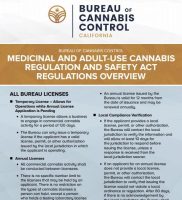Last week, the California Bureau of Cannabis Control released their proposed emergency regulations for the industry. The Bureau, the government agency tasked with regulating California’s cannabis industry, announced the proposed emergency regulations ahead of the highly anticipated January 2018 start date.
The Bureau also published helpful fact sheets and overview documents, providing a good snapshot of the major requirements for different types of licenses. Here are some of the key takeaways:
Temporary licenses will allow businesses to operate for 120 days while their annual license application is being processed. Not surprisingly, local jurisdictions have considerable autonomy. Getting a license seems to be contingent on first getting local approval to operate. According to Josh Drayton, communications and outreach director at the California Cannabis Industry Association (CCIA), working with local governments will be crucial to making progress. “Now that the Brown Administration has created the framework for medical and adult use cannabis, the main challenge we face as an industry is getting local municipalities to move forward with regulations,” says Drayton. “California has a dual licensing process which means that cannabis operators must receive a local permit/license/authorization before being able to apply for a state license. A majority of California cities and counties have yet to finalize their regulations which will delay state licensing.”
The initial reactions to these proposed regulations seem positive, given that this is a culmination of efforts over several years. “The California Cannabis Industry Association welcomes the release of the emergency regulations,” says Drayton. “These regulations represent years of hard work and collaboration between the administration, the regulating departments, and the cannabis industry.”
License Distinctions
A-type licenses are for businesses in the adult-use market, while M-type licenses are for the medical market. Laboratory licenses don’t have this distinction, as they can test both medical and adult-use products.
The record keeping and security requirements seem relatively straightforward, requiring normal surveillance measures like 24-hour video, commercial-grade locks and alarm systems. The rules also lay out guidelines for disposing of waste, including securing it on the premises and not selling it.
Distributors
Distributor licenses appear to have a number of compliance documentation requirements, such as arranging for all product testing, quality assurance and packaging and label accuracy. “Cannabis and cannabis products must pass through a distributor prior to being sold to customers at a retail establishment,” reads the overview the Bureau published. There is also a transport-only distributor license option. Those regulations appear to be more comprehensive than others, with a number of regulations pertaining to appropriate transportation and security measures.
Everything has to be packaged before it gets to retail; Retailers are not allowed to package or label cannabis products on premises. Microbusiness licenses will be available, which should be an exciting new development to follow as the market matures.
Labs
The state will require ISO 17025 accreditation for testing labs. A provisional license is required for a lab to operate in the short term, expiring after 12 months. Laboratory personnel are required to go in the field and do the sampling. Documentation requirements, sample sizes, sampling procedures and storage and transportation rules are also laid out.
Testing labs are required to test for cannabinoids, foreign material, heavy metals, microbial impurities, mycotoxins, moisture content and water activity, residual pesticides, residual solvents and processing chemicals and terpenoids (terpenes). Infused and edible products are required to be tested for homogeneity in THC and CBD concentrations as well. Drayton and the CCIA welcome these new testing regulations, hoping it might improve overall public safety. “We believe that these regulations will address public health issues by mandating the testing of all cannabis products,” says Drayton. “The evolution of the cannabis industry will continue, and we will continue to advocate for good policy that creates solutions for the problems that arise. I believe that we will be visiting and revisiting cannabis regulations for many years to come.”
Certificates of analysis (COA) will be required, showing whether a batch passes or fails testing requirements. Harvest batches that fail testing can be processed for remediation. “Testing laboratories are required to develop and implement a quality assurance program that is sufficient to ensure the reliability and validity of the analytical data produced by the laboratory,” reads the statement on QA and QC.
The Bureau, at the end of their regulatory overview document, lays out some possible enforcement actions, disciplinary actions and citations that could come from noncompliance. “These emergency regulations create a framework for both medical and adult use consumers,” says Drayton. “January 1, 2018 will be the first date that adults 21 years and older will be able to purchase cannabis without a medical card.”
In the coming weeks, we’ll be breaking down and analyzing the other proposed emergency regulations that the state released. Stay tuned for a breakdown of the California Department of Food & Agriculture (CDFA) regulations on cannabis cultivation, as well as The California Department of Public Health (CDPH) cannabis manufacturing regulations.



